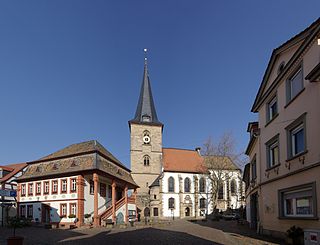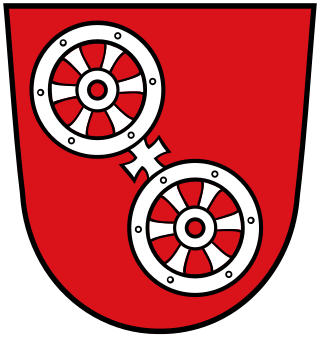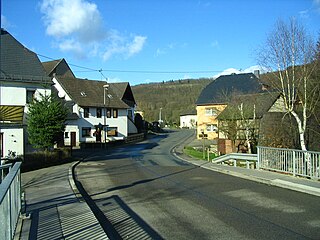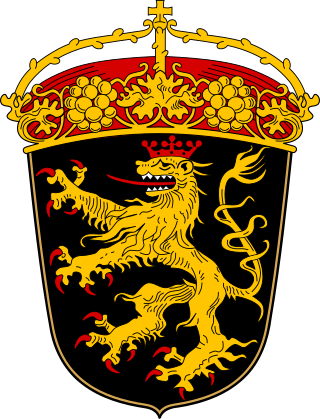Mainz-Bingen is a district (Kreis) in the east of Rhineland-Palatinate, Germany. Neighboring districts are Rheingau-Taunus, the district-free cities Wiesbaden and Mainz, the districts Groß-Gerau, Alzey-Worms, Bad Kreuznach, and Rhein-Hunsrück.
Rhein-Lahn-Kreis is a district (Kreis) in the east of Rhineland-Palatinate, Germany. Neighboring districts are Westerwaldkreis, Limburg-Weilburg, Rheingau-Taunus, Mainz-Bingen, Rhein-Hunsrück, Mayen-Koblenz, and the district-free city Koblenz.
Südliche Weinstraße is a district (Kreis) in the south of Rhineland-Palatinate, Germany. Neighboring districts are Südwestpfalz, Bad Dürkheim, the district-free city Neustadt (Weinstraße), Rhein-Pfalz-Kreis, Germersheim, and the French département Bas-Rhin. The district-free city Landau is surrounded by the district.

Freinsheim is a town in the Bad Dürkheim district in Rhineland-Palatinate, Germany. With about 5,000 inhabitants, it is among the state's smaller towns. It is also the seat of the like-named Verbandsgemeinde, a kind of collective municipality.

The coat of arms of the German state of Baden-Württemberg features a greater and a lesser version.

The German state of Brandenburg has a coat of arms depicting a red eagle.

The Wheel of Mainz or Mainzer Rad, in German, was the coat of arms of the Archbishopric of Mainz and thus also of the Electorate of Mainz (Kurmainz), in Rhineland-Palatinate, Germany. It consists of a silver wheel with six spokes on a red background. The wheel can also be found in stonemasons' carvings and similar objects. Currently, the City of Mainz uses a double wheel connected by a silver cross.

Hahnenbach is an Ortsgemeinde – a municipality belonging to a Verbandsgemeinde, a kind of collective municipality – in the Bad Kreuznach district in Rhineland-Palatinate, Germany. It belongs to the Verbandsgemeinde Kirner Land, whose seat is in the town of Kirn. Hahnenbach is a state-recognized tourism community.

Hergenfeld is an Ortsgemeinde – a municipality belonging to a Verbandsgemeinde, a kind of collective municipality – in the Bad Kreuznach district in Rhineland-Palatinate, Germany. It belongs to the Verbandsgemeinde of Rüdesheim, whose seat is in the municipality of Rüdesheim an der Nahe. Hergenfeld is a winegrowing village.

Königsau is an Ortsgemeinde – a municipality belonging to a Verbandsgemeinde, a kind of collective municipality – in the Bad Kreuznach district in Rhineland-Palatinate, Germany. It belongs to the Verbandsgemeinde Kirner Land, whose seat is in the town of Kirn.

Schwarzerden is an Ortsgemeinde – a municipality belonging to a Verbandsgemeinde, a kind of collective municipality – in the Bad Kreuznach district in Rhineland-Palatinate, Germany. It belongs to the Verbandsgemeinde Kirner Land, whose seat is in the town of Kirn.

This article is about the coat of arms of the German state of Saarland.

Bennhausen is a municipality in the Donnersbergkreis district, in Rhineland-Palatinate, Germany. It belongs to the Verbandsgemeinde of Kirchheimbolanden.

Dienheim is an Ortsgemeinde – a municipality belonging to a Verbandsgemeinde, a kind of collective municipality – in the Mainz-Bingen district in Rhineland-Palatinate, Germany.

Schwabenheim an der Selz is an Ortsgemeinde – a municipality belonging to a Verbandsgemeinde, a kind of collective municipality – in the Mainz-Bingen district in Rhineland-Palatinate, Germany.

Hungenroth is an Ortsgemeinde – a municipality belonging to a Verbandsgemeinde, a kind of collective municipality – in the Rhein-Hunsrück-Kreis (district) in Rhineland-Palatinate, Germany.

Oberotterbach is a municipality in Südliche Weinstraße district, in Rhineland-Palatinate, western Germany.

The flag of Rhineland-Palatinate, also known as Rhineland-Pfalz, is a tricolor of three horizontal bands of black, red and gold. These colors are Germany's national colors and are sometimes referred to as schwarz-rot-gold. In the canton, or the upper left corner, is the coat of arms of the state of Rhineland-Palatinate.

The Verdienstmedaille des Landes Rheinland-Pfalz is a civil order of merit, of the German State of Rhineland-Palatinate, whose Foundation on February 13, 1996 was carried out by Minister-President of Rhineland-Palatinate Kurt Beck. The award of the Medal of Merit is given as a sign of recognition and appreciation of special voluntary contributions to society and their fellow human beings, especially in the areas of corporate, social, cultural, sporty life as well as in environmental and nature conservation.

The Palatine Lion, less commonly the Palatinate Lion, is an heraldic charge. It was originally part of the family coat of arms of the House of Wittelsbach and is found today on many coats of arms of municipalities, counties and regions in South Germany and the Austrian Innviertel.




















